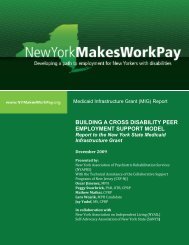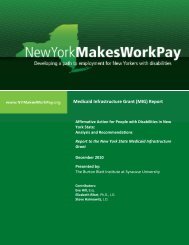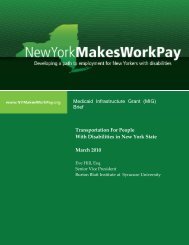Disability & Employment Law in New York State - Cornell University
Disability & Employment Law in New York State - Cornell University
Disability & Employment Law in New York State - Cornell University
You also want an ePaper? Increase the reach of your titles
YUMPU automatically turns print PDFs into web optimized ePapers that Google loves.
<strong>Disability</strong> & <strong>Employment</strong> <strong>Law</strong> <strong>in</strong> <strong>New</strong> <strong>York</strong> <strong>State</strong>:Analysis and Recommendationsprovided, however, that such actions do not impose an undue hardship onthe bus<strong>in</strong>ess, program or enterprise of the entity from which action isrequested. 53The def<strong>in</strong>ition is <strong>in</strong>tentionally broad, <strong>in</strong> acknowledg<strong>in</strong>g a few common examples, but nottry<strong>in</strong>g to create a comprehensive list of what accommodations are reasonable. This isimportant, because given the wide variation of disabilities <strong>in</strong> existence, even a verythoughtful or lengthy list of possible accommodations likely would fail to anticipate what<strong>in</strong>dividuals with disabilities may need.In order to be considered reasonable under the NYSHRL, the accommodation must beeffective, mean<strong>in</strong>g that it should enable the employee to accomplish needed tasks, andshould be appropriate to the disability. 54 Where an employee develops or discloses adisability, and the employer term<strong>in</strong>ates an employee before allow<strong>in</strong>g the employee topursue or secure an accommodation, the employer may prevail, if it can demonstratethat, had the accommodation been provided, it would not have been effective. 55 Thereis no consistent standard among the <strong>New</strong> <strong>York</strong> courts for determ<strong>in</strong><strong>in</strong>g what a“reasonable manner” entails; however, some courts have resorted to the ADA,56suggest<strong>in</strong>g that the standard should be the same.Under the ADA, if an employee can perform a job with or without reasonableaccommodation, then s/he is “qualified” to do the job. If an employee develops adisability which <strong>in</strong>terferes with performance of essential job functions, even withaccommodation, then the employer may not be liable for tak<strong>in</strong>g an adverse action suchas term<strong>in</strong>ation, because the employee is no longer qualified. However, the ADA alsoprovides that when an employee becomes unable to perform at a job s/he waspreviously able to manage, the duty to accommodate also <strong>in</strong>cludes reassignment of theemployee to a vacant position that the employee is qualified for, before consider<strong>in</strong>gterm<strong>in</strong>ation. 57 As yet, the NYSHRL is silent on to what extent reassignment is required.A recent, <strong>in</strong>fluential appellate court decision, Phillips v. City of <strong>New</strong> <strong>York</strong>, <strong>in</strong>terpreted therequirement of reasonable accommodation to allow up to a year of medical leave, evenif an employee is unable to perform job tasks dur<strong>in</strong>g that period, as long as the medicalleave will enable the employee to work <strong>in</strong> the future. 58 In addition, the Phillips courtasserted that it is the employer’s responsibility under the NYSHRL to make an53 N.Y. Exec. <strong>Law</strong> § 292(21-e).54 Id.55 Gill v. Maul, 876 N.Y.S.2d 751 (3rd Dept. 2009)56 Gill, 876 N.Y.S.2d at 753; Pimentel v. Citibank, N.A., 811 N.Y.S.2d 381, 386 (1st Dept. 2007); Engelman v. GirlScouts‐Indian Hills Council, Inc., 791 N.Y.S.2d 735, 736‐37 (3d Dept. 2005); Gilbert v. Frank, 949 F.2d 637, 642 (2dCir.1991); Pembroke v. <strong>New</strong> <strong>York</strong> <strong>State</strong> Off. of Ct. Adm<strong>in</strong>., 761 N.Y.S.2d 214, 215 (1st Dept 2003); Rappo v. <strong>New</strong><strong>York</strong> <strong>State</strong> Div. of Human Rights, 868 N.Y.S.2d 59 (1st Dept. 2008).57See http://www.eeoc.gov/policy/docs/accommodation.html#reassignment. See also, e.g., U.S.Airways, Inc. v. Barnett, 535 U.S. 391 (2002); Prilliman v. United Airl<strong>in</strong>es, Inc., 62 Cal Rptr.2d 142 (Cal.Ct. App. 1997); Blanton v. Inco Alloys International, Inc., 108 F.3d 104 (6 th Cir. 1997).58 Phillips v. City of <strong>New</strong> <strong>York</strong>, 884 N.Y.S.2d 369, 380 (1st Dept. 2009).10





